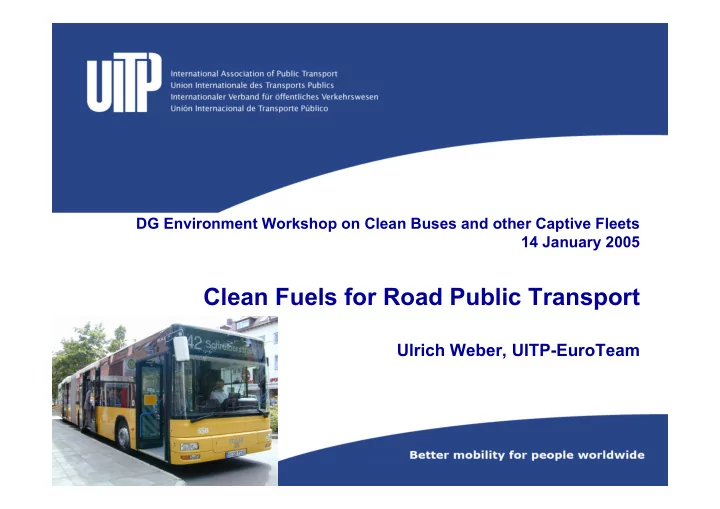

DG Environment Workshop on Clean Buses and other Captive Fleets 14 January 2005 Clean Fuels for Road Public Transport Ulrich Weber, UITP-EuroTeam
UITP Report on Clean Fuels for Road Public Transport (2004)
Clean fuels for road public transport A study report from the UITP Bus Committee – Expertise from 35 bus operating companies from 20 countries (Berlin, Paris, New York, Milan, Barcelona, Amsterdam, Vienna,..) – Rich experience in operating city buses ( … purchasing, servicing, maintaining and repairing the vehicles … ) Objective of the report – Give a review of all current available fuels – Present available experiences from operators using clean fuels in terms of reliability, maintainability, costs (purchase and operating), safety and service improvement
Clean fuels for road public transport Content: � Recommendations for measurement tests not on engine but on vehicle basis: SORT (Standardised On Road Test Cycles) method � Review of the propellants/technologies available for PT: (a) carbon-based fuels/fossils (diesel, CNG, LPG, etc.) (b) renewable options (biofuels like vegetable oil, biomass and hydrogen) (c) applications of electrical energy (trolley buses, batteries, hybrids, fuel cells)
Current Changes and Developments � Clean diesel technologies (e.g. particle filter…) have been developed along with the entry into strict standards � Synthetic fuels such as water-diesel emulsions are available � Biofuels such as biodiesel and diester are available � Alternative fossil fuels (e.g. CNG) have managed a significant market breakthrough � Electric driven vehicles have been put into commercial service � Fuel cell technology has been/is tested intensively
Compliance with EEV Standard Project “challenging environmental standards in PT competition” (German Ministry of Environment, 2004): � EEV can be reached with CNG and Diesel technologies! 25 Diesel buses in Berlin 22 CNG buses in Frankfurt/Oder
The Way to reach Euro V/EEV with Diesel Buses - 2 Strategies - DPF (z.B. CRT) + AGR (oder SCR) EGR Motor (PM-opt.) + SCR PM emissions SCR DPF NOx/PM (CRT) M o t o r ( P M - o p t ) SCR EURO V NOx emissions
Influence of CRT Systems on Particle Size 100 % 80 n o i s s 60 i m e e l c 40 i t r a P 20 0 10-30 nm 30-100 nm 100-300 nm Particle size without CRT with CRT
The Price of Change Initial extra capital costs (compared to a 12m diesel bus at 200.000 €) CNG LPG Diesel + Diesel + CRT SCRT Vehicle 40.000 € 30.000 € 5.000 – 10.000 € 6.000 € Filling 0,3 to 0,22 - - station 0,6 Mio € Mio € Safety 0,03 to 1 Mio € - - devices 1 Mio € Cleaning - - 25.000 € 25.000 € installations Source: UITP Bus Committee
Conclusion 1: Clean Vehicles and Alternative Fuels have extra Costs � Diesel technology is still the most economic solution and offers with EGR/SCR and particle filters compliance with highest emission standards (EEV) � Technology/fuel independent incentives for clean vehicles � Local authorities and transport undertakings should be free to choose their best strategy on how resources are allocated to obtain a clean fleet � Extra costs for changing to clean vehicles and alternative fuels have to be taken into account and should not lead to a counterproductive cut in the PT service offer
Experiences from New Member States � Relatively old bus fleets Example Bratislava: 504 buses – 42 % after lifetime, 131 trolley buses – 80 % after lifetime Example Lithuania: 80 % of all buses are more than 10 years old � Serious problem: only very limited financial resources for purchase of new vehicles/modernising old vehicles and maintenance of PT infrastructure � More European structural funds dedicated to local PT would be a solution
Relative Responsibilities for Emissions in Urban Areas CO 100 80 60 40 CO2 HC 8 20 Total 5 6 Transport 0 7,7 Public Transport 9 PM NOx (Source: UITP Focus Paper 2000)
Fuel Consumption of selected Transport Modes (per Person) Liters/100 km 10 Porsche Cayenne Turbo: 1998 2020 PT Public Transport 23 liters/100 * 1,2 Persons per Car 8 7,4 ** Average Consumption per Day kilometers *** Consumption in Rush Hours 6 5,2 Articulated MB Citaro: 60 liters/100 kilometers today today 4 1,7 2 1,2 1 0,7 0 Car * PT ** PT *** Metro ** Metro *** (Source: Shell Study)
CO2 Emissions of selected Transport Modes in Relation to Cars Per Cent in Prozent Cars 1998 Pkw 1998 100 Cars 2020 Pkw 2020 70,4 Airplanes Flugzeug 74,1 PT in Average ÖPNV im Durchschnitt 25,9 PT during Rush Hours ÖPNV in Verkehrsspitze 14,8 Metro in Average Stadtbahn im Durchschnitt 18,5 Metro during Rush Hours Stadtbahn in Verkehrsspitze 9,9 PT Bus in Average Lininebus im Durchschnitt 38,3 PT Bus dg. Rush Hours Linienbus in Verkehrsspitze 7,4 0 20 40 60 80 100 (Source: Shell Study)
Conclusion 2: Comprehensive Strategy to solve transport related problems in urban areas is necessary! � Modal shift from individual motorized transport to more environmentally friendly modes of transport such as public transport, cycling and walking will be the key solution in urban areas for: � Reducing pollutants � Reducing GHG emissions � Reducing accidents and improving road safety � Reducing space consumption � Reducing congestion 3 km/h increase in average commercial speed of London bus lines resulted in reduction of ~ 50 % of all major pollutants + GHG emissions!
Recommend
More recommend